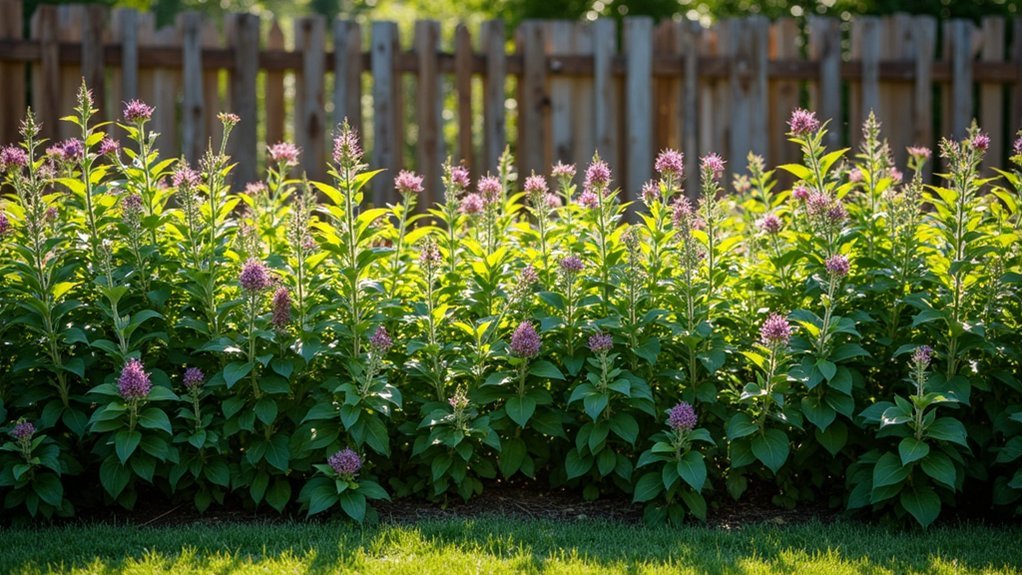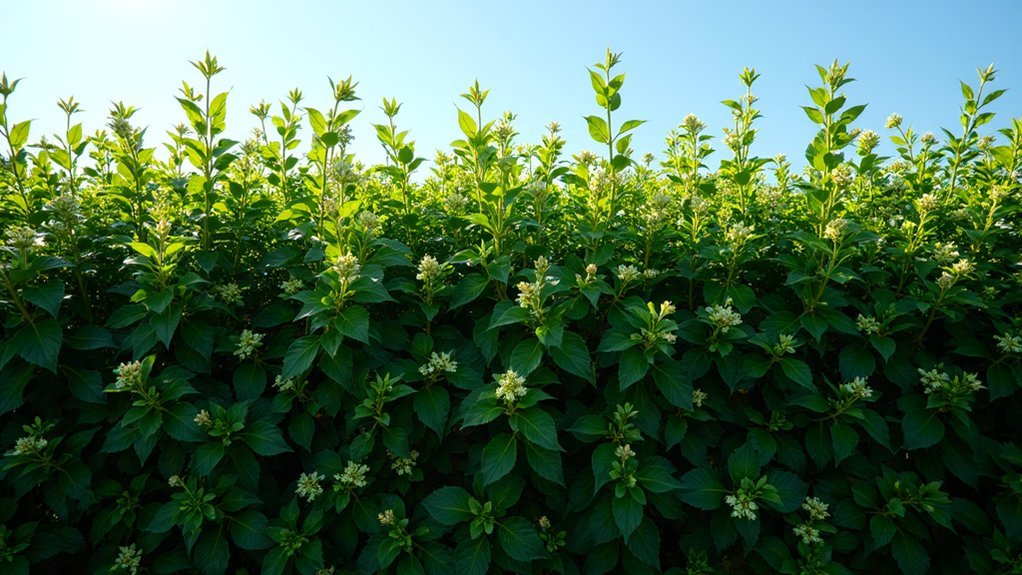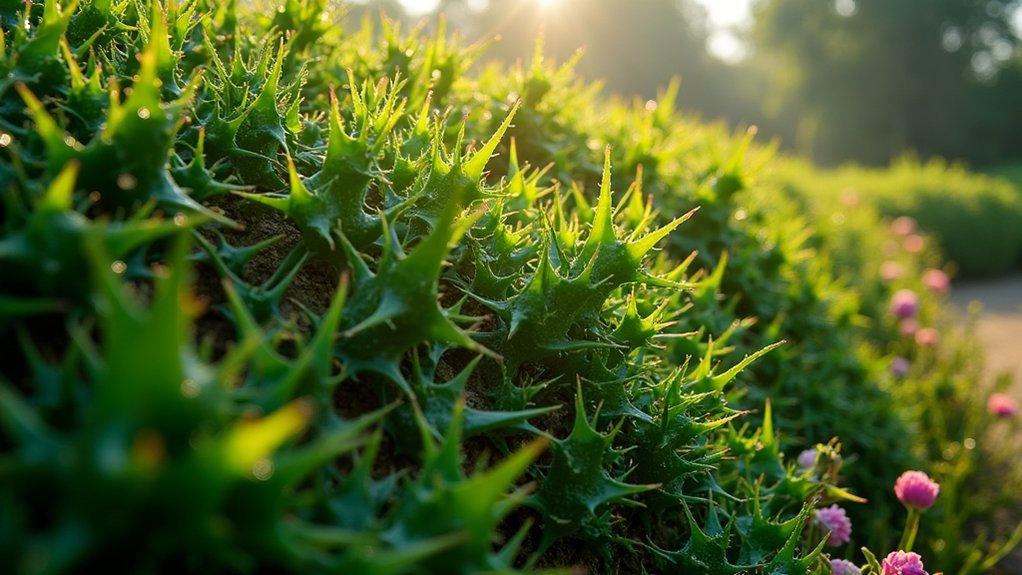Non-toxic thorny hedges like Pyracantha, English Holly, Mahonia, Rosa rugosa, and Barrel Cactus create effective barriers against intruders. You’ll get year-round protection with these plants that strengthen over time while enhancing your property’s appearance and supporting wildlife. Plant them 1-3 feet apart in fall for ideal growth, arranging taller species at boundaries with medium shrubs in the middle. These living fences offer more benefits than traditional security at lower long-term costs.
Understanding the Benefits of Plant-Based Security Barriers

When considering security for your property, plant-based barriers offer compelling advantages that extend far beyond simple protection. Unlike conventional fencing, thorny hedges actively contribute to carbon sequestration while preventing soil erosion on your land.
You’ll find these natural barriers require less maintenance over time, saving you money while eliminating the disposal concerns of traditional barriers. They integrate seamlessly with local ecosystems, supporting wildlife and enhancing biodiversity around your home.
Plant barriers can increase your property value through their aesthetic appeal while creating greener spaces that benefit your mental and physical health. Research shows living near vegetation reduces stress and improves air quality. The growing interest in these natural security solutions aligns with broader sustainability trends in home landscaping.
Additionally, you’ll be creating job opportunities in your community while preserving cultural landscapes that reflect local heritage.
Top 5 Defensive Hedge Species for Home Perimeters
Selecting the right defensive hedge species transforms your perimeter into a beautiful but formidable security barrier.
Pyracantha offers year-round protection with sharp thorns that can penetrate leather, growing up to 4 meters with attractive white flowers and berries.
English Holly provides dense, prickly foliage that deters climbing while attracting wildlife, though it grows slowly at 10-15cm annually.
Mahonia’s spiny leaves act like natural barbed wire, reaching 3 meters with winter-blooming yellow flowers and adaptability to various soils. When placing these defensive plants, ensure they don’t block escape routes during emergencies.
For arid climates, Barrel Cactus creates an effective ground-level deterrent with its radial spines.
Finally, prickly rose varieties like Rosa rugosa form impassable thickets while offering beautiful blooms and fragrance, effectively disguising their defensive purpose.
How Thorny Hedges Outperform Traditional Fencing

While protective hedge species offer excellent defensive capabilities, their advantages extend far beyond mere deterrence.
You’ll find thorny hedges are typically more cost-effective than traditional fencing, with lower initial investment and minimal long-term maintenance costs.
Unlike static fences, these living barriers strengthen with age, creating increasingly impenetrable boundaries that deter intruders more effectively over time.
They’re remarkably durable, withstanding storms better than conventional fencing while requiring only occasional pruning.
The environmental benefits are substantial—thorny hedges reduce your carbon footprint, stabilize soil, improve air quality, and provide essential wildlife habitat. These natural barriers can thrive for centuries longer than typical fencing materials that deteriorate over decades.
They’ll enhance your property’s aesthetic appeal with seasonal changes and natural greenery, potentially increasing your home’s value while simultaneously offering superior noise reduction and wind protection compared to conventional barriers.
Creating Impenetrable Barriers: Planting Strategies for Maximum Deterrence
To create a truly impenetrable security barrier, you’ll need strategic planting techniques that maximize both defensive capabilities and aesthetic appeal. Plant your security hedge in fall to establish strong root systems before growth begins. Layer your plants strategically—taller species at boundaries, medium shrubs in the middle, and thorny groundcover in front. These natural barriers offer more than just security; they provide structural refuge for vulnerable seedlings and young trees that would otherwise be decimated by herbivores.
| Planting Zone | Primary Plants | Companion Plants |
|---|---|---|
| Boundary Line | Blackthorn, Hawthorn | Firethorn, Osage Orange |
| Middle Layer | Blackberry, Bougainvillea | Mixed thorny shrubs |
| Ground Level | Eastern Prickly Pear | Crown of Thorns |
Prepare soil with compost and mulch with straw or leaves to suppress weeds. Incorporating diverse species creates a more resilient barrier while supporting local wildlife. Regular pruning guarantees your hedge remains dense and effective while maintaining its deterrent properties.
The Science Behind Natural Defense Mechanisms in Plants

Plants have evolved thorns as defensive structures over millions of years to protect themselves against hungry herbivores.
While chemical defenses like toxins and tannins work internally to poison or disrupt digestion, physical barriers such as thorns and spines create immediate external deterrents that discourage feeding before it begins. Unlike true thorns, roses actually have pointed epidermal outgrowths that botanically classify as prickles.
You’ll find this evolutionary arms race has produced remarkably effective security features that you can strategically incorporate into your property defenses.
Evolution of Plant Thorns
Throughout millions of years, thorns, spines, and prickles have emerged as remarkable defensive adaptations in response to the relentless pressure of mammalian herbivores. This evolutionary arms race has driven plants to develop increasingly sophisticated defenses as herbivores adapt to existing ones. Recent research suggests that these defensive structures may have evolved primarily to deter insect herbivores rather than mammals as traditionally believed.
You’ll find thorny structures across various plant families through convergent evolution—different species independently developing similar solutions to common threats. These defenses take diverse forms: sharpened branches in citrus plants, converted leaf spines in cacti like Opuntia, and barbed prickles in roses.
Originally evolving in resource-poor environments where plants couldn’t easily regenerate after damage, thorns now serve multiple purposes. Beyond deterring hungry animals, they provide structural support for climbing plants and help reduce water loss in arid conditions—showcasing nature’s efficiency in solving multiple problems with single adaptations.
Chemical vs. Physical Defenses
The remarkable evolutionary journey of thorns represents just one defense strategy in plants’ complex security arsenal. Plants employ both chemical and physical tactics to deter herbivores and guarantee survival. For example, Acacia species have developed hollow thorns that provide shelter for protective ants in a fascinating mutualistic relationship.
| Defense Type | Examples | Effectiveness |
|---|---|---|
| Chemical | Alkaloids, terpenoids, phenols | Target specific herbivores, often inducible |
| Physical | Thorns, spines, trichomes | Constant protection, resource-efficient |
| Hybrid | Secretory trichomes, nectar thorns | Synergistic effects, attracts predators |
You’ll find that plants with strong physical defenses may invest less in chemical ones due to resource trade-offs. While chemicals require metabolic energy but offer targeted protection, physical barriers provide constant defense at lower maintenance costs—making thorny species particularly valuable for security hedging applications.
Growth Rates and Establishment Timeline for Security Hedges
When planning a thorny security hedge, understanding growth rates and establishment timelines helps you set realistic expectations for your defensive barrier.
Most thorny hedges like Hawthorn (Crataegus monogyna) grow moderately fast in favorable conditions, while Pyracantha can establish quickly with proper care.
Plant your hedges 1-3 feet apart depending on desired density. The first two years focus on root development with minimal visible growth.
Years 2-5 bring accelerated growth as your security barrier takes shape. By year 5, you’ll have a mature, effective deterrent.
Soil quality, sunlight, and consistent watering greatly impact growth rates. Regular pruning maintains density while encouraging new growth.
For faster establishment, consider adding fertilizer during planting and throughout the development phases. Fall is the ideal planting time for most thorny hedges when they’re dormant and can establish strong roots before the growing season.
Wildlife-Friendly Security: Balancing Defense and Biodiversity

While establishing your thorny hedge takes time, the rewards extend far beyond security alone.
You’ll create a thriving ecosystem that deters intruders while supporting local wildlife. Species like Blackthorn, Holly, and Hawthorn offer protective barriers with their sharp thorns while providing essential habitat for birds, insects, and small mammals.
These living boundaries serve as wildlife corridors, connecting fragmented habitats and supporting hundreds of species.
You’ll notice increased biodiversity as your hedge supplies food through berries, nectar-rich flowers for pollinators, and shelter for nesting birds. These natural barriers are more aesthetically pleasing than traditional fences while providing superior protection and ecological benefits.
Year-Round Protection: Selecting Hedges for Seasonal Coverage
Achieving year-round security requires careful selection of hedges that maintain their defensive properties regardless of season.
Evergreen varieties like Portuguese Laurel, English Laurel, and Cherry Laurel offer consistent coverage with their dense, glossy foliage that persists through all seasons.
Laurel hedges provide uncompromising security with lush, persistent foliage that stands sentinel throughout the year.
For rapid barrier formation, consider fast-growing options like Virescens Western Red Cedar, which tolerates various light conditions while maintaining year-round greenery.
Some laurel species grow over a foot annually, quickly establishing thick screens.
American Arborvitae cultivars like ‘Emerald Green’ and ‘Green Giant’ provide dense needle-type coverage in all climates.
For tougher barriers, select yew shrubs with their needle-like foliage creating prickly, impenetrable hedges even in winter.
Choose climate-adapted varieties that require minimal maintenance—most need only annual pruning to maintain their defensive structure.
Yukon Belle® Pyracantha creates an effective security screen with its bright-orange winter berries while providing visual interest that attracts birds to your landscape.
Maintenance Guide for Long-Term Defensive Hedge Effectiveness

To maintain the effectiveness of defensive hedges over many years, you’ll need a strategic approach that addresses both routine care and long-term health considerations.
Establish a regular pruning schedule to encourage dense, bushy growth, cutting main stems to stimulate new growth from the base.
Apply mulch to suppress weeds and retain moisture, while feeding plants annually with general-purpose fertilizer to support vigor.
Monitor your hedges for pests and diseases, addressing issues promptly to prevent deterioration.
Consider implementing a renewal strategy for older sections to maintain ideal thorn density and barrier strength.
In exposed locations, provide temporary shelter for young hedges during establishment.
Install efficient irrigation systems like soaker hoses to guarantee consistent moisture, especially during the critical first two years after planting.
Species like hollies and firethorns create impenetrable barriers while providing aesthetic benefits through year-round color and foliage.
Cost Comparison: Natural Hedge Barriers vs. Conventional Security Systems
Beyond maintenance considerations, budget often becomes the deciding factor when choosing security solutions for your property.
Initial costs for thorny hedges ($8-25 per linear foot) compare favorably to conventional fencing ($15-50) and electronic systems that require substantial hardware investments ($300-1,500+).
Natural security solutions deliver premium protection at a fraction of traditional system costs.
You’ll find long-term economics even more compelling. While hedges need $3-5 annually per foot for maintenance, fences demand $4-10+ for repairs. Bamboo varieties establish quickly and offer dense privacy screens within just 2-3 growing seasons.
Electronic systems become obsolete within 5-7 years and incur monthly fees ($10-100), while hedges thrive for decades.
The hidden value tilts further toward natural barriers. Hedges increase property values 3-5%, support biodiversity, and sequester carbon.
They also avoid permitting hassles common with tall fences while offering multi-functional benefits like edible berries or medicinal properties.
Frequently Asked Questions
Will Thorny Hedges Damage Pets That Accidentally Run Into Them?
Yes, your pets may suffer scratches or puncture wounds if they run into thorny hedges. However, most thorny hedges aren’t toxic, and with proper training, pets can learn to avoid these prickly barriers.
Are These Defensive Plants Safe to Grow Near Children’s Play Areas?
No, you shouldn’t plant thorny hedges near children’s play areas. They pose injury risks even when non-toxic. Instead, create distance between defensive plants and play spaces to protect your children from accidental harm.
Can Thorny Hedges Be Planted Alongside Existing Fencing for Extra Security?
Yes, you can plant thorny hedges alongside existing fencing for enhanced security. They’ll create a multilayered defense system that deters intruders while adding aesthetic appeal and wildlife habitat to your property boundary.
How Do Intruder-Deterrent Hedges Affect Property Insurance Premiums?
While thorny hedges may reduce your insurance premiums by improving security, most insurers don’t offer specific discounts for them. You’ll see greater benefits when combining hedges with other security measures like alarms.
Can Defensive Hedges Be Strategically Trimmed to Create Emergency Escape Routes?
Yes, you can strategically trim defensive hedges to create emergency escape routes. Maintain clear passages by selectively thinning lower branches while preserving the barrier’s security function. Regular maintenance guarantees exits remain accessible during emergencies.
In Summary
Thorny hedges offer you a sustainable, effective deterrent against intruders while enhancing your property’s beauty and ecological value. You’ll find options like barberry, pyracantha, and hawthorn provide formidable defense without toxicity concerns. They’re cost-effective alternatives to traditional security systems and require minimal maintenance once established. By selecting the right species and implementing proper planting techniques, you’ve created a natural security barrier that works year-round.





Leave a Reply